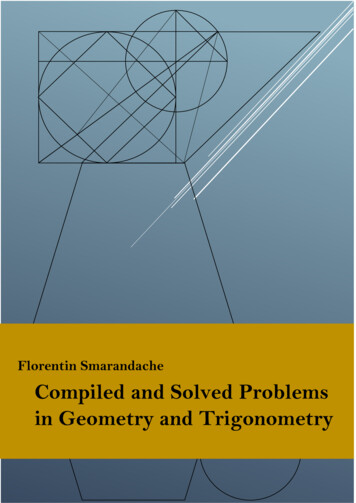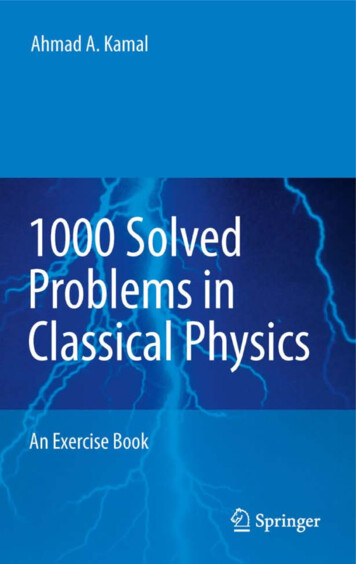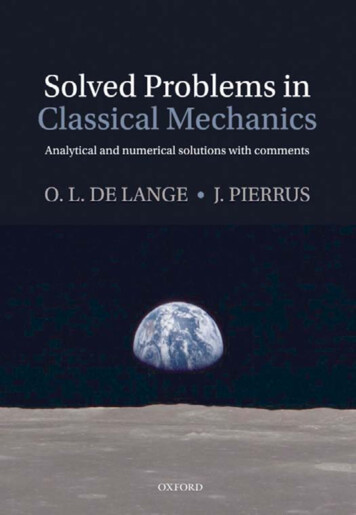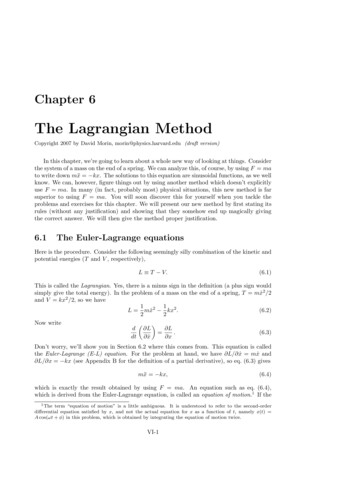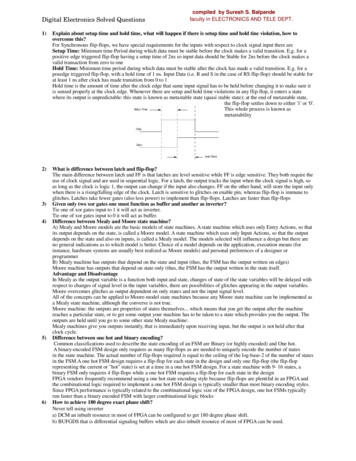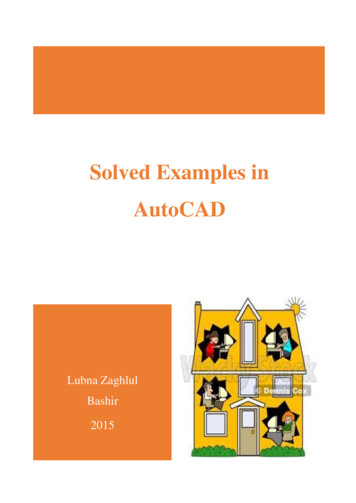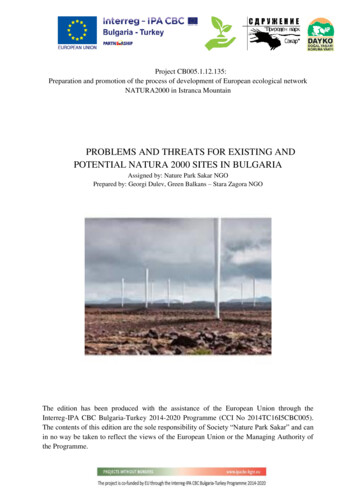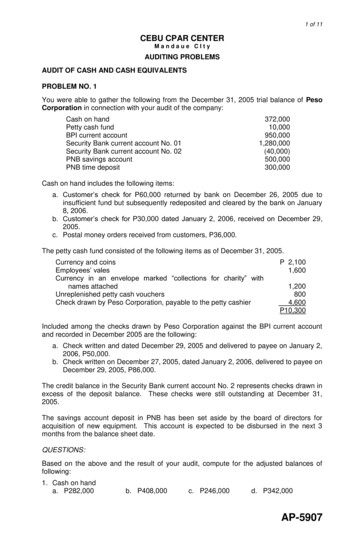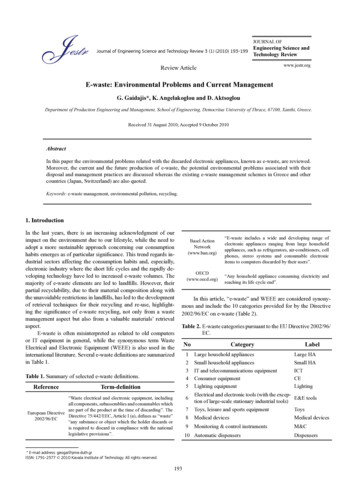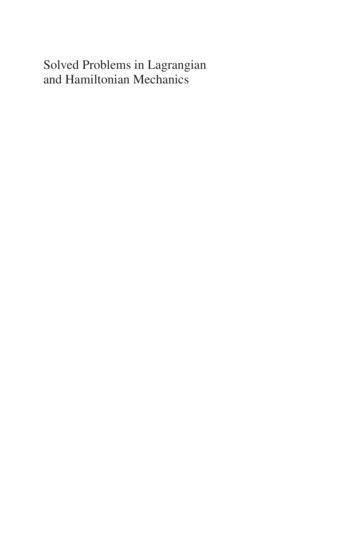
Transcription
Solved Problems in Lagrangianand Hamiltonian Mechanics
Grenoble SciencesGrenoble Sciences pursues a triple aim: to publish works responding to a clearly defined project, with no curriculum orvogue constraints, to guarantee the selected titles’ scientific and pedagogical qualities, to propose books at an affordable price to the widest scope of readers.Each project is selected with the help of anonymous referees, followed by anaverage one-year interaction between the authors and a Readership Committeewhose members’ names figure in the front pages of the book. Grenoble Sciencesthen signs a co-publishing agreement with the most adequate publisher.Contact: Tel.: (33) (0) 4 76 51 46 95 - Fax: (33) (0) 4 76 51 45 79E-mail: Grenoble.Sciences@ujf-grenoble.frWebsite: http://grenoble-sciences.ujf-grenoble.frScientific Director of Grenoble Sciences: Jean B ORNAREL,Professor at the Joseph Fourier University, Grenoble, FranceGrenoble Sciences is supported by the French Ministry of HigherEducation and Research and the “Région Rhône-Alpes”.The Solved Problems in Lagrangian and Hamiltonian MechanicsReading Committee included the following members: Robert ARVIEU, Professor at the Joseph Fourier University, Grenoble, France Jacques MEYER, Professor at the Nuclear Physics Institute, Claude BernardUniversity, Lyon, Francewith the contribution of: Myriam REFFAY and Bertrand RUPHThe translation of “Problèmes corrigés de Mécanique et résumés de cours. DeLagrange à Hamilton”, published by Grenoble Sciences in partnership with EDPSciences, was performed by: Bernard SILVESTRE-BRAC and Anthony John COLE, Senior researcher at theCNRS, Grenoble, FranceFront cover illustration: composed by Alice GIRAUD
Claude Gignoux · Bernard Silvestre-BracSolved Problemsin Lagrangianand Hamiltonian Mechanics123
Dr. Claude GignouxUniversité Joseph FourierLab. Physique Subatomique etCosmologieCNRS-IN2P353 avenue des Martyrs38026 Grenoble CXFranceclaude.gignoux@club-internet.frDr. Bernard Silvestre-BracUniversité Joseph FourierLab. Physique Subatomique etCosmologieCNRS-IN2P353 avenue des Martyrs38026 Grenoble CXFrancesilvestre@lpsc.in2p3.frISBN 978-90-481-2392-6e-ISBN 978-90-481-2393-3DOI 10.1007/978-90-481-2393-3Springer Dordrecht Heidelberg London New YorkLibrary of Congress Control Number: 2009926952c Springer Science Business Media B.V. 2009 No part of this work may be reproduced, stored in a retrieval system, or transmitted in any form or byany means, electronic, mechanical, photocopying, microfilming, recording or otherwise, without writtenpermission from the Publisher, with the exception of any material supplied specifically for the purposeof being entered and executed on a computer system, for exclusive use by the purchaser of the work.Printed on acid-free paperSpringer is part of Springer Science Business Media (www.springer.com)
ForewordMechanics is an old science, but it acquired its great reputation at theend of the 17th century, due to Newton’s works. A century later, Eulerand, above all, Lagrange renewed it and led it towards a formulation notonly aesthetically elegant but also capable of applications to other fields ofphysics. Fifty years later, Hamilton and Jacobi gave their names to veryimportant further contributions. Lastly, at the end of the xixth century,Poincaré took a new step with the introduction of geometry in the analysisof physical problems. During the xxth century, physicists produced newdevelopments from the works of their famous predecessors.This book is addressed to readers already familiar with the Newtonianapproach for mechanics. Several training textbooks – some of them excellent– rely on this approach. On the other hand, it seems that exercises based onLagrangian and Hamiltonian formulations are rather scarce in the literature;we hope that the present work may help to fill this gap.In a previous book published in French by EDP, Grenoble-Sciences collection, under the name La mécanique: de la formulation lagrangienne auchaos hamiltonien, we proposed, for undergraduate students, a comprehensible synthesis of all the modern facets of mechanics and their relationshipsto other domains of physics. This textbook contains a great number of exercises and problems, many of them original, dealing with the theories ofLagrange, Hamilton and Poincaré. We gave only the results or brief hintsfor solving these problems. Some problems can be considered as difficult,or even disconcerting, and readers encouraged us to provide the solution ofthose exercises which illustrate all the topics presented in the book. Thisis the aim of the present work. We retained from the foregoing book mostof the problems presented here, very often trying to make them clearer,sometimes trying to find interesting extensions. We also proposed new onesbetter suited to our pedagogic goal. In the same spirit, others have beenwithdrawn because we judged them less instructive for physics, even if themathematical points they dealt with were logical consequences of featurestreated in the textbook.Of course, the present work is a natural complement of the course-book;nevertheless, we have tried to make it self-contained and, with this in mind,
viForewordwe add in each chapter a succinct, although clear and complete, summary ofeach topic. These summaries are adequate to tackle and solve the problemspresented afterwards; every concept or notion necessary for obtaining thesolution is presented and developed therein. Our aim is to make the readerfamiliar with the Lagrangian and Hamiltonian approaches, which may bedifficult to grasp, to demonstrate the power of this formalism and help todevelop skills for managing the techniques essential for this kind of study.The problems are selected with this purpose and they illustrate very oftenpractical physical situations and sometimes aspects of everyday life.This book is built around eight chapters entitled:1. The Lagrangian formulation2. Lagrangian systems3. Hamilton’s principle (also called the least action principle)4. The Hamiltonian formalism5. The Hamilton-Jacobi formalism6. Integrable systems7. Quasi-integrable systems8. From order to chaosIn each chapter, the reader will find: A clear, succinct and rather deep summary of all the notions that mustbe understood, the important points that must be memorized and thenotations and symbols used in the problems. The statements of the problems which are presented consecutively. Thesestatements are sufficiently detailed so that, with the help of the lessonsummaries, it is unnecessary for the reader to search for other sourcesof information. Whenever a figure turns out to be essential for a goodunderstanding of the text, it appears in the statement. The progressivedifficulty of the problems is symbolized with an increasing number ofstars (from 1 to 3) added to the title. Detailed answers to the problems which are grouped together at the endof the chapter. A number of additional figures are inserted in the corresponding text in order to exhibit essential points or to avoid lengthycircumlocutions.At the beginning of the book, a synoptic table gathers, chapter by chapter, the set of all the proposed problems, giving, for each of them, its reference (number, title, page number), its difficulty (1 to 3 stars), as well asthe important features or the peculiar aspects treated in this problem.
ForewordviiTwo purposes are pursued To concretize, through simple and often academic examples, notions thatseem apparently very abstract. The methods to find the solution are notnecessarily the most elegant or the quickest, but it is important to check,via these simple examples, one’s understanding of these new tools formechanics. Sometimes the same problem, or the same physical situation,is studied once more in a subsequent chapter with new tools in order toemphasize some novel feature of the method. To emphasize the power of these new tools in physics applied to fields asmiscellaneous as traditional mechanics, optics, electromagnetism, wavesin general, and quantum mechanics. Concerning these fascinating and upto date subjects in physics, we will focus only on the mechanical aspect.However, the reader could satisfy his curiosity, with help of keywords,by looking for further information firstly in a good and complete encyclopedia, then on the web using a engine such as Google (or, for moreexotic subjects, Yahoo). He will find exhaustive lectures as well as recentarticles.We strongly recommend that the reader carries out some applications anddraws the figures proposed in the detailed solutions. For the drawing orplotting of curves, the authors have used the freewares xfig or xmgrace thatcan be downloaded from the web. The differential equations have beensolved with the help of the Mathematica software package.
AcknowledgmentWe are very grateful to the reading committee for all remarks and suggestions which were very helpful in achieving a greater degree of consistencyand an improved pedagogical quality in this work. We also very much appreciated contributions from our students whose enthusiasm and variousquestions allowed us to make the text more understandable.Finally, we wish to thank members of the editorial board, Nicole Sauvaland Jean Bornarel, for their competent advice, Sylvie Bordage, Julie Ridardand Thierry Morturier for their role in improving our figures and KonstantinProtasov for his helpful work concerning the layout of the manuscript.A work such as ours is never perfect neither in the form nor in theessence of the matter. If, despite the care brought by the authors in theconstruction of this work, you find mistakes, shortcomings or incoherences,we will be grateful to you for mentioning them via one of the followingelectronic @lpsc.in2p3.fr
ContentsForeword . . . . . . . . . . . . . . . . . . . . . . . . . . . . . . . . . . . . . . . . . . . . . . . . . . . . . . . . . vContents . . . . . . . . . . . . . . . . . . . . . . . . . . . . . . . . . . . . . . . . . . . . . . . . . . . . . . . . . xiSynoptic Tables of the Problems . . . . . . . . . . . . . . . . . . . . . . . . . . . . . . 1Chapter 1. The Lagrangian Formulation . . . . . . . . . . . . . . . . . . . . 9Summary . . . . . . . . . . . . . . . . . . . . . . . . . . . . . . . . . . . . . . . . . . . . . . . . . . . . . . . . 91.1. Generalized Coordinates . . . . . . . . . . . . . . . . . . . . . . . . . . . . . . . . . 91.2. Lagrange’s Equations . . . . . . . . . . . . . . . . . . . . . . . . . . . . . . . . . . . 101.3. Generalized Forces . . . . . . . . . . . . . . . . . . . . . . . . . . . . . . . . . . . . . . 121.4. Lagrange Multipliers . . . . . . . . . . . . . . . . . . . . . . . . . . . . . . . . . . . . 13Problem Statements . . . . . . . . . . . . . . . . . . . . . . . . . . . . . . . . . . . . . . . . . . . 141.1. The Wheel Jack . . . . . . . . . . . . . . . . . . . . . . . . . . . . . . . . . . . . . . . . 141.2. The Sling . . . . . . . . . . . . . . . . . . . . . . . . . . . . . . . . . . . . . . . . . . . . . . . 151.3. Rope Slipping on a Table . . . . . . . . . . . . . . . . . . . . . . . . . . . . . . . 161.4. Reaction Force for a Bead on a Hoop . . . . . . . . . . . . . . . . . . . 161.5. Huygens Pendulum . . . . . . . . . . . . . . . . . . . . . . . . . . . . . . . . . . . . . 171.6. Cylinder Rolling on a Moving Tray . . . . . . . . . . . . . . . . . . . . . 181.7. Motion of a Badly Balanced Cylinder . . . . . . . . . . . . . . . . . . . 181.8. Free Axle on a Inclined Plane . . . . . . . . . . . . . . . . . . . . . . . . . . . 191.9. The Turn Indicator . . . . . . . . . . . . . . . . . . . . . . . . . . . . . . . . . . . . . 211.10. An Experiment to Measure the Rotational Velocityof the Earth . . . . . . . . . . . . . . . . . . . . . . . . . . . . . . . . . . . . . . . . . . . . 221.11. Generalized Inertial Forces . . . . . . . . . . . . . . . . . . . . . . . . . . . . . . 23Problem Solutions . . . . . . . . . . . . . . . . . . . . . . . . . . . . . . . . . . . . . . . . . . . . . 241.1. The Wheel Jack . . . . . . . . . . . . . . . . . . . . . . . . . . . . . . . . . . . . . . . . 241.2. The Sling . . . . . . . . . . . . . . . . . . . . . . . . . . . . . . . . . . . . . . . . . . . . . . . 261.3. Rope Slipping on a Table . . . . . . . . . . . . . . . . . . . . . . . . . . . . . . . 271.4. Reaction Force for a Bead on a Hoop . . . . . . . . . . . . . . . . . . . 281.5. The Huygens Pendulum . . . . . . . . . . . . . . . . . . . . . . . . . . . . . . . . 311.6. Cylinder Rolling on a Moving Tray . . . . . . . . . . . . . . . . . . . . . 331.7. Motion of a Badly Balanced Cylinder . . . . . . . . . . . . . . . . . . . 351.8. Free Axle on a Inclined Plane . . . . . . . . . . . . . . . . . . . . . . . . . . . 391.9. The Turn Indicator . . . . . . . . . . . . . . . . . . . . . . . . . . . . . . . . . . . . . 431.10. An Experiment to Measure the Rotational Velocityof the Earth . . . . . . . . . . . . . . . . . . . . . . . . . . . . . . . . . . . . . . . . . . . . 461.11. Generalized Inertial Forces . . . . . . . . . . . . . . . . . . . . . . . . . . . . . . 48
xiiContentsChapter 2. Lagrangian Systems . . . . . . . . . . . . . . . . . . . . . . . . . . . . . . 51Summary . . . . . . . . . . . . . . . . . . . . . . . . . . . . . . . . . . . . . . . . . . . . . . . . . . . . . . . 512.1. Generalized Potential . . . . . . . . . . . . . . . . . . . . . . . . . . . . . . . . . . . 512.2. Lagrangian System . . . . . . . . . . . . . . . . . . . . . . . . . . . . . . . . . . . . . 522.3. Constants of the Motion . . . . . . . . . . . . . . . . . . . . . . . . . . . . . . . . 532.4. Two-body System with Central Force . . . . . . . . . . . . . . . . . . . 552.5. Small Oscillations . . . . . . . . . . . . . . . . . . . . . . . . . . . . . . . . . . . . . . . 56Problem Statements . . . . . . . . . . . . . . . . . . . . . . . . . . . . . . . . . . . . . . . . . . . 572.1. Disc on a Movable Inclined Plane . . . . . . . . . . . . . . . . . . . . . . . 572.2. Painlevé’s Integral . . . . . . . . . . . . . . . . . . . . . . . . . . . . . . . . . . . . . . 582.3. Application of Noether’s Theorem . . . . . . . . . . . . . . . . . . . . . . 582.4. Foucault’s Pendulum . . . . . . . . . . . . . . . . . . . . . . . . . . . . . . . . . . . 592.5. Three-particle System . . . . . . . . . . . . . . . . . . . . . . . . . . . . . . . . . . 612.6. Vibration of a Linear Triatomic Molecule:The “Soft” Mode . . . . . . . . . . . . . . . . . . . . . . . . . . . . . . . . . . . . . . . . 632.7. Elastic Transversal Waves in a Solid . . . . . . . . . . . . . . . . . . . . 642.8. Lagrangian in a Rotating Frame . . . . . . . . . . . . . . . . . . . . . . . . 652.9. Particle Drift in a Constant Electromagnetic Field . . . . . . 662.10. The Penning Trap . . . . . . . . . . . . . . . . . . . . . . . . . . . . . . . . . . . . . . 672.11. Equinox Precession . . . . . . . . . . . . . . . . . . . . . . . . . . . . . . . . . . . . . 682.12. Flexion Vibration of a Blade . . . . . . . . . . . . . . . . . . . . . . . . . . . . 712.13. Solitary Waves . . . . . . . . . . . . . . . . . . . . . . . . . . . . . . . . . . . . . . . . . . 732.14. Vibrational Modes of an Atomic Chain . . . . . . . . . . . . . . . . . 75Problem Solutions . . . . . . . . . . . . . . . . . . . . . . . . . . . . . . . . . . . . . . . . . . . . . 762.1. Disc on a Movable Inclined Plane . . . . . . . . . . . . . . . . . . . . . . . 762.2. Painlevé’s Integral . . . . . . . . . . . . . . . . . . . . . . . . . . . . . . . . . . . . . . 772.3. Application of Noether’s Theorem . . . . . . . . . . . . . . . . . . . . . . 782.4. Foucault’s Pendulum . . . . . . . . . . . . . . . . . . . . . . . . . . . . . . . . . . . 792.5. Three-particle System . . . . . . . . . . . . . . . . . . . . . . . . . . . . . . . . . . 822.6. Vibration of a Linear Triatomic Molecule:The “Soft” Mode . . . . . . . . . . . . . . . . . . . . . . . . . . . . . . . . . . . . . . . . 862.7. Elastic Transversal Waves in a Solid . . . . . . . . . . . . . . . . . . . . 882.8. Lagrangian in a Rotating Frame . . . . . . . . . . . . . . . . . . . . . . . . 892.9. Particle Drift in a Constant Electromagnetic Field . . . . . . 912.10. The Penning Trap . . . . . . . . . . . . . . . . . . . . . . . . . . . . . . . . . . . . . . 942.11. Equinox Precession . . . . . . . . . . . . . . . . . . . . . . . . . . . . . . . . . . . . . 972.12. Flexion Vibration of a Blade . . . . . . . . . . . . . . . . . . . . . . . . . . . 1022.13. Solitary Waves . . . . . . . . . . . . . . . . . . . . . . . . . . . . . . . . . . . . . . . . 1052.14. Vibrational Modes of an Atomic Chain . . . . . . . . . . . . . . . . 107Chapter 3. Hamilton’s Principle . . . . . . . . . . . . . . . . . . . . . . . . . . . .Summary . . . . . . . . . . . . . . . . . . . . . . . . . . . . . . . . . . . . . . . . . . . . . . . . . . . . . .3.1. Statement of the Principle . . . . . . . . . . . . . . . . . . . . . . . . . . . . .3.2. Action Functional . . . . . . . . . . . . . . . . . . . . . . . . . . . . . . . . . . . . .111111111112
Contentsxiii3.3. Action and Field Theory . . . . . . . . . . . . . . . . . . . . . . . . . . . . . . .3.4. Some Well Known Actions . . . . . . . . . . . . . . . . . . . . . . . . . . . . .3.5. The Calculus of Variations . . . . . . . . . . . . . . . . . . . . . . . . . . . . .Problem Statements . . . . . . . . . . . . . . . . . . . . . . . . . . . . . . . . . . . . . . . . . .3.1. The Lorentz Force . . . . . . . . . . . . . . . . . . . . . . . . . . . . . . . . . . . . .3.2. Relativistic Particle in a Central Force Field . . . . . . . . . . .3.3. Principle of Least Action? . . . . . . . . . . . . . . . . . . . . . . . . . . . . .3.4. Minimum or Maximum Action? . . . . . . . . . . . . . . . . . . . . . . .3.5. Is There Only One SolutionWhich Makes the Action Stationary? . . . . . . . . . . . . . . . . . .3.6. The Principle of Maupertuis . . . . . . . . . . . . . . . . . . . . . . . . . . .3.7. Fermat’s Principle . . . . . . . . . . . . . . . . . . . . . . . . . . . . . . . . . . . . .3.8. The Skier Strategy . . . . . . . . . . . . . . . . . . . . . . . . . . . . . . . . . . . .3.9. Free Motion on an Ellipsoid . . . . . . . . . . . . . . . . . . . . . . . . . . .3.10. Minimum Area for a Fixed Volume . . . . . . . . . . . . . . . . . . . .3.11. The Form of Soap Films . . . . . . . . . . . . . . . . . . . . . . . . . . . . . . .3.12. Laplace’s Law for Surface Tension . . . . . . . . . . . . . . . . . . . . .3.13. Chain of Pendulums . . . . . . . . . . . . . . . . . . . . . . . . . . . . . . . . . . .3.14. Wave Equation for a Flexible Blade . . . . . . . . . . . . . . . . . . . .3.15. Precession of Mercury’s Orbit . . . . . . . . . . . . . . . . . . . . . . . . . .Problem Solutions . . . . . . . . . . . . . . . . . . . . . . . . . . . . . . . . . . . . . . . . . . . .3.1. The Lorentz Force . . . . . . . . . . . . . . . . . . . . . . . . . . . . . . . . . . . . .3.2. Relativistic Particle in a Central Force Field . . . . . . . . . . .3.3. Principle of Least Action? . . . . . . . . . . . . . . . . . . . . . . . . . . . . .3.4. Minimum or Maximum Action? . . . . . . . . . . . . . . . . . . . . . . .3.5. Is There Only One SolutionWhich Makes the Action Stationary? . . . . . . . . . . . . . . . . . .3.6. The Principle of Maupertuis . . . . . . . . . . . . . . . . . . . . . . . . . . .3.7. Fermat’s Principle . . . . . . . . . . . . . . . . . . . . . . . . . . . . . . . . . . . . .3.8. The Skier Strategy . . . . . . . . . . . . . . . . . . . . . . . . . . . . . . . . . . . .3.9. Free Motion on an Ellipsoid . . . . . . . . . . . . . . . . . . . . . . . . . . .3.10. Minimum Area for a Fixed Volume . . . . . . . . . . . . . . . . . . . .3.11. The Form of Soap Films . . . . . . . . . . . . . . . . . . . . . . . . . . . . . . .3.12. Laplace’s Law for Surface Tension . . . . . . . . . . . . . . . . . . . . .3.13. Chain of Pendulums . . . . . . . . . . . . . . . . . . . . . . . . . . . . . . . . . . .3.14. Wave Equation for a Flexible Blade . . . . . . . . . . . . . . . . . . . .3.15. Precession of Mercury’s Orbit . . . . . . . . . . . . . . . . . . . . . . . . . .112113114116116117118119Chapter 4. Hamiltonian Formalism . . . . . . . . . . . . . . . . . . . . . . . . .Summary . . . . . . . . . . . . . . . . . . . . . . . . . . . . . . . . . . . . . . . . . . . . . . . . . . . . . .4.1. Generalized Momentum . . . . . . . . . . . . . . . . . . . . . . . . . . . . . . . .4.2. Hamilton’s Function . . . . . . . . . . . . . . . . . . . . . . . . . . . . . . . . . . .4.3. Hamilton’s Equations . . . . . . . . . . . . . . . . . . . . . . . . . . . . . . . . . .4.4. Liouville’s Theorem . . . . . . . . . . . . . . . . . . . . . . . . . . . . . . . . . . . 28131131132135137138141144146150152154158160161162
xivContents4.5. Autonomous One-dimensional Systems . . . . . . . . . . . . . . . . .4.6. Periodic One-dimensional Hamiltonian Systems . . . . . . . .Problem Statements . . . . . . . . . . . . . . . . . . . . . . . . . . . . . . . . . . . . . . . . . .4.1. Electric Charges Trapped in Conductors . . . . . . . . . . . . . . .4.2. Symmetry of the Trajectory . . . . . . . . . . . . . . . . . . . . . . . . . . .4.3. Hamiltonian in a Rotating Frame . . . . . . . . . . . . . . . . . . . . . .4.4. Identical Hamiltonian Flows . . . . . . . . . . . . . . . . . . . . . . . . . . .4.5. The Runge-Lenz Vector . . . . . . . . . . . . . . . . . . . . . . . . . . . . . . . .4.6. Quicker and More Ecologic than a Plane . . . . . . . . . . . . . . .4.7. Hamiltonian of a Charged Particle . . . . . . . . . . . . . . . . . . . . .4.8. The First Integral Invariant . . . . . . . . . . . . . . . . . . . . . . . . . . . .4.9. What About Non-Autonomous Systems? . . . . . . . . . . . . . .4.10. The Reverse Pendulum . . . . . . . . . . . . . . . . . . . . . . . . . . . . . . . .4.11. The Paul Trap . . . . . . . . . . . . . . . . . . . . . . . . . . . . . . . . . . . . . . . . .4.12. Optical Hamilton’s Equations . . . . . . . . . . . . . . . . . . . . . . . . . .4.13. Application to Billiard Balls . . . . . . . . . . . . . . . . . . . . . . . . . . .4.14. Parabolic Double Well . . . . . . . . . . . . . . . . . . . . . . . . . . . . . . . . .4.15. Stability of Circular Trajectories in a Central Potential4.16. The Bead on the Hoop . . . . . . . . . . . . . . . . . . . . . . . . . . . . . . . .4.17. Trajectories in a Central Force Field . . . . . . . . . . . . . . . . . . .Problem Solutions . . . . . . . . . . . . . . . . . . . . . . . . . . . . . . . . . . . . . . . . . . . .4.1. Electric Charges Trapped in Conductors . . . . . . . . . . . . . . .4.2. Symmetry of the Trajectory . . . . . . . . . . . . . . . . . . . . . . . . . . .4.3. Hamiltonian in a Rotating Frame . . . . . . . . . . . . . . . . . . . . . .4.4. Identical Hamiltonian Flows . . . . . . . . . . . . . . . . . . . . . . . . . . .4.5. The Runge-Lenz Vector . . . . . . . . . . . . . . . . . . . . . . . . . . . . . . . .4.6. Quicker and More Ecologic than a Plane . . . . . . . . . . . . . . .4.7. Hamiltonian of a Charged Particle . . . . . . . . . . . . . . . . . . . . .4.8. The First Integral Invariant . . . . . . . . . . . . . . . . . . . . . . . . . . . .4.9. What About Non-Autonomous Systems? . . . . . . . . . . . . . .4.10. The Reverse Pendulum . . . . . . . . . . . . . . . . . . . . . . . . . . . . . . . .4.11. The Paul Trap . . . . . . . . . . . . . . . . . . . . . . . . . . . . . . . . . . . . . . . . .4.12. Optical Hamilton’s Equations . . . . . . . . . . . . . . . . . . . . . . . . . .4.13. Application to Billiard Balls . . . . . . . . . . . . . . . . . . . . . . . . . . .4.14. Parabolic Double Well . . . . . . . . . . . . . . . . . . . . . . . . . . . . . . . . .4.15. Stability of Circular Trajectories in a Central Potential4.16. The Bead on the Hoop . . . . . . . . . . . . . . . . . . . . . . . . . . . . . . . .4.17. Stability of Circular Trajectories in a Central 07211214216219222224228Chapter 5. Hamilton-Jacobi Formalism . . . . . . . . . . . . . . . . . . . .Summary . . . . . . . . . . . . . . . . . . . . . . . . . . . . . . . . . . . . . . . . . . . . . . . . . . . . . .5.1. The Action Function . . . . . . . . . . . . . . . . . . . . . . . . . . . . . . . . . . .5.2. Reduced Action . . . . . . . . . . . . . . . . . . . . . . . . . . . . . . . . . . . . . . .5.3. Maupertuis’ Principle . . . . . . . . . . . . . . . . . . . . . . . . . . . . . . . . . .233233233234235
Contentsxv5.4. Jacobi’s Theorem . . . . . . . . . . . . . . . . . . . . . . . . . . . . . . . . . . . . . .5.5. Separation of Variables . . . . . . . . . . . . . . . . . . . . . . . . . . . . . . . .5.6. Huygens’ Construction . . . . . . . . . . . . . . . . . . . . . . . . . . . . . . . . .Problem Statements . . . . . . . . . . . . . . . . . . . . . . . . . . . . . . . . . . . . . . . . . .5.1. How to Manipulate the Action and the Reduced Action5.2. Action for a One-dimensional Harmonic Oscillator . . . . .5.3. Motion on a Surface and Geodesic . . . . . . . . . . . . . . . . . . . . .5.4. Wave Surface for Free Fall . . . . . . . . . . . . . . . . . . . . . . . . . . . . .5.5. Peculiar Wave Fronts . . . . . . . . . . . . . . . . . . . . . . . . . . . . . . . . . .5.6. Electrostatic Lens . . . . . . . . . . . . . . . . . . . . . . . . . . . . . . . . . . . . .5.7. Maupertuis’ Principle with an Electromagnetic Field . . .5.8. Separable Hamiltonian, Separable Action . . . . . . . . . . . . . .5.9. Stark Effect . . . . . . . . . . . . . . . . . . . . . . . . . . . . . . . . . . . . . . . . . . .5.10. Orbits of Earth’s Satellites . . . . . . . . . . . . . . . . . . . . . . . . . . . . .5.11. Phase and Group Velocities . . . . . . . . . . . . . . . . . . . . . . . . . . . .Problem Solutions . . . . . . . . . . . . . . . . . . . . . . . . . . . . . . . . . . . . . . . . . . . .5.1. How to Manipulate the Action and the Reduced Action5.2. Action for a One-Dimensional Harmonic Oscillator . . . . .5.3. Motion on a Surface and Geodesic . . . . . . . . . . . . . . . . . . . . .5.4. Wave Surface for Free Fall . . . . . . . . . . . . . . . . . . . . . . . . . . . . .5.5. Peculiar Wave Fronts . . . . . . . . . . . . . . . . . . . . . . . . . . . . . . . . . .5.6. Electrostatic Lens . . . . . . . . . . . . . . . . . . . . . . . . . . . . . . . . . . . . .5.7. Maupertuis’ Principle with an Electromagnetic Field . . .5.8. Separable Hamiltonian, Separable Action . . . . . . . . . . . . . .5.9. Stark Effect . . . . . . . . . . . . . . . . . . . . . . . . . . . . . . . . . . . . . . . . . . .5.10. Orbits of Earth’s Satellites . . . . . . . . . . . . . . . . . . . . . . . . . . . . .5.11. Phase and Group Velocities . . . . . . . . . . . . . . . . . . . . . . . . . . . 52258260261264265268270271275279Chapter 6. Integrable Systems . . . . . . . . . . . . . . . . . . . . . . . . . . . . . .Summary . . . . . . . . . . . . . . . . . . . . . . . . . . . . . . . . . . . . . . . . . . . . . . . . . . . . . .6.1. Basic Notions . . . . . . . . . . . . . . . . . . . . . . . . . . . . . . . . . . . . . . . . . .6.1.1. Some Definitions . . . . . . . . . . . . . . . . . . . . . . . . . . . . . . . .6.1.2. Good Coordinates: The Angle–Action Variables .6.2. Complements . . . . . . . . . . . . . . . . . . . . . . . . . . . . . . . . . . . . . . . . . .6.2.1. Building the Angle Variables . . . . . . . . . . . . . . . . . . . .6.2.2. Flow/Poisson Bracket/Involution . . . . . . . . . . . . . . . .6.2.3. Criterion to Obtain a Canonical Transformation .Problem Statements . . . . . . . . . . . . . . . . . . . . . . . . . . . . . . . . . . . . . . . . . .6.1. Expression of the Period for a One-Dimensional Motion6.2. One-dimensional Particle in a Box . . . . . . . . . . . . . . . . . . . . .6.3. Ball Bouncing on the Ground . . . . . . . . . . . . . . . . . . . . . . . . . .6.4. Particle in a Constant Magnetic Field . . . . . . . . . . . . . . . . . .6.5. Actions for the Kepler Problem . . . . . . . . . . . . . . . . . . . . . . . .6.6. The Sommerfeld Atom . . . . . . . . . . . . . . . . . . . . . . . . . . . . . . . . .6.7. Energy as a Function of Actions . . . . . . . . . . . . . . . . . . . . . . 94
xviContents6.8. Invariance of the Circulation Under a ContinuousDeformation . . . . . . . . . . . . . . . . . . . . . . . . . . . . . . . . . . . . . . . . . . .6.9. Ball Bouncing on a Moving Tray . . . . . . . . . . . . . . . . . . . . . . .6.10. Harmonic Oscillator with a Variable Frequency . . . . . . . .6.11. Choice of the Momentum . . . . . . . . . . . . . . . . . . . . . . . . . . . . . .6.12. Invariance of the Poisson BracketUnder a Canonical Transformation . . . . . . . . . . . . . . . . . . . . .6.13. Canonicity for a Contact Transformation . . . . . . . . . . . . . .6.14. One-Dimensional Free Fall . . . . . . . . . . . . . . . . . . . . . . . . . . . . .6.15. One-Dimensional Free Fall Again . . . . . . . . . . . . . . . . . . . . . .6.16. Scale Dilation as a Function of Time . . . . . . . . . . . . . . . . . . .6.17. From the Harmonic Oscillator to Coulomb’s Problem . .6.18. Generators for Fundamental Transformations . . . . . . . . . .Problem Solutions . . . . . . . . . . . . . . . . . . . . . . . . . . . . . . . . . . . . . . . . . . . .6.1. Expression of the Period for a One-Dimensional Motion6.2. One-Dimensional Particle in a Box . . . . . . . . . . . . . . . . . . . . .6.3. Ball Bouncing on the Ground . . . . . . . . . . . . . . . . . . . . . . . . . .6.4. Particle in a Constant Magnetic Field . . . . . . . . . . . . . . . . . .6.5. Actions for the Kepler Problem . . . . . . . . . . . . . . . . .
The Solved Problems in Lagrangian and Hamiltonian Mechanics Reading Committee included the following members: Robert ARVIEU, Professor at the Joseph Fourier University, Grenoble, France Jacques MEYER, Professor at the Nuclear Physics Institute, Claude Bernard University, Lyon, France
